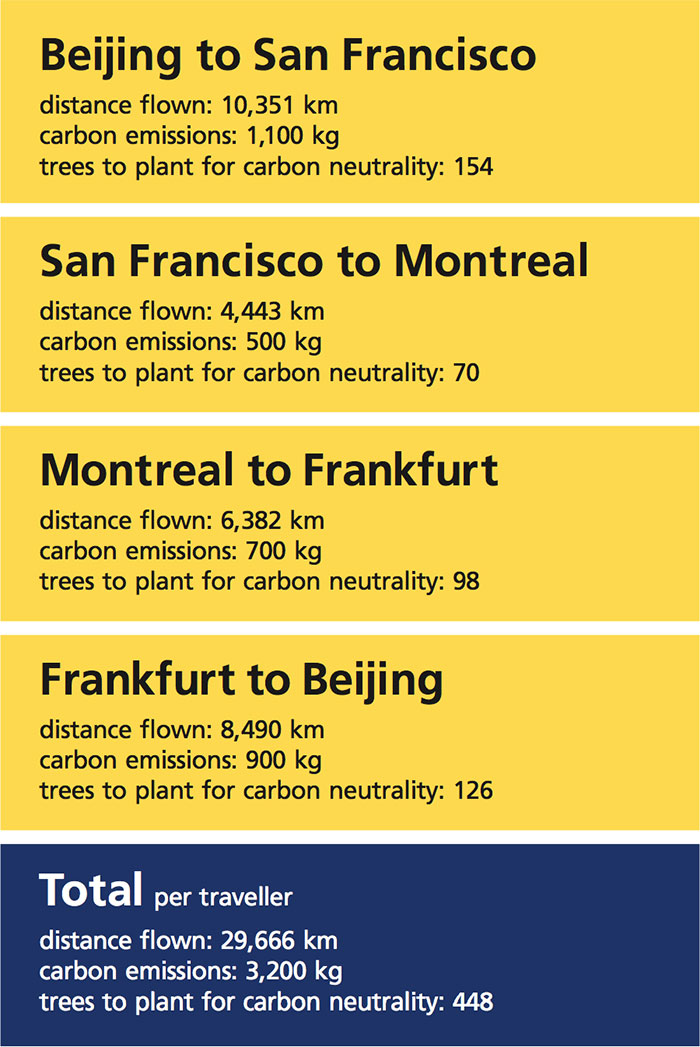
Iremember being very young in the family backyard in California, looking skyward with my father at the passing airplanes. He helped me learn each shape, assigning names and purposes: transport, airliner, fighter. Before I was born, he had piloted a fighter jet, and he would tell stories of tearing up the heavens with his friends, of signing out a Grumman F9F-8 in the morning, flying more than 1,500 kilometres to have dinner with his parents, then climbing back into his cockpit the next morning and returning to base, six tonnes of kerosene fuel and a weekend well burned.
Air travel has lost most of its mystique in the half century since, but that does not make the fact of mechanical flight any less impressive. On a sunny day, at the end of runway 26R at Vancouver International Airport, you may find a half-dozen people enjoying the spectacle of a 363,000-kilogram jumbo jet surfing the air. I show up on a misty and brooding morning, and because the wind is blowing out to sea, the airliners come and go on the other side of the airport. They sound like receding thunder. The tall grass whips and shivers. I am alone. It’s easy to imagine a day, maybe not so far off, when the number of jets in the sky will have dwindled dramatically. A time when such huge birds might again seem exotic.
Could it happen? As the potential ravages of global warming come more solidly into view, jet travel has been fingered as a dangerous emitter of greenhouse gases. And now the price of oil is said by various experts to be headed toward $200 (US) a barrel within the year, maybe five, a sign for many that we’ve entered a new age of fossil fuel scarcity. What if we come to decide jet travel has become too polluting to risk our children’s future? Or just far too expensive to continue flying the kids to Disneyland?
And if a million such decisions were to cause the jet age to end, how would we come back to earth? Softly, one would hope. Pleasantly. But maybe, instead, it will be a white-knuckle crash.
George Monbiot, Guardian columnist and author of the 2006 bestseller Heat: How to Stop the Planet from Burning, wants a forced landing—immediately. Jet travel, he states, is “the greatest future cause of global warming.” And people who fly are “killers.”
At present, aviation accounts for only about 2 percent of total human carbon emissions, according to the Intergovernmental Panel on Climate Change. But because jets fly so high, their effect on global warming is near-tripled. Monbiot calculates that the industry is growing so fast that within decades jet travel will erase most potential climate-friendly gains in other sectors.
The European Union has responded by including aviation in its carbon emissions trading scheme as of 2012. Next year, the United Kingdom will charge a carbon tax on all flights within and out of the country. Here in North America, neither approach is close at hand. British Columbia’s “cutting-edge” carbon tax will apply to flights inside the province but not those with outside connections. And jet fuel itself can’t be taxed by any nation; international trade agreements prevent it.
Some airlines will let you choose to spend more to buy carbon offsets, but such volunteer programs aren’t likely to give the planet’s thermostat much of a shove. After a year of offering the option, Air Canada reports its passengers bought a mere $131,529 in carbon offsets, worth a puny 1,644 trees. People might step up to buy a lot more carbon offsets if the “messaging” were better and “fully integrated into the ticket purchasing experience,” says Joe Kelly, director of environmental services for InterVistas, a Canadian firm that consults for airline and tourism companies. His survey shows that “people need to feel confident their money is really going to make a difference.” He adds, “Of course, a lot of people say one thing and do another.”
He also points out that Boeing will soon roll out its carbon-fibre-bodied 787 Dreamliner, said to be 20 percent more fuel efficient than its predecessors. And an April press release from the International Air Transport Association trumpeted “a historic commitment to tackle climate change” and a vision for “a carbon emission free industry.”
Monbiot takes no solace from any of it. The window on defeating global warming is closing rapidly, and governments must ground the fleets now. Like an angry preacher who has glimpsed hellfire, he spreads his gospel. “When I challenge my friends about their planned weekend in Rome or their holiday in Florida,” he writes, “they respond with a strange, distant smile and avert their eyes…The moral dissonance is deafening.” He’s not the only one championing the latest environmental commandment: thou shalt not fly. “Making selfish choices such as flying on holiday,” preaches the bishop of London, Richard Chartres, is “a symptom of sin.”
Yes, perhaps. But business is booming. As the middle classes of China and India take to the sky, the global airline industry expects passengers to double to 9 billion in twenty-five years. If this comes to pass, even aviation’s most optimistic expectation of further carbon emission cuts, admits Kelly, will be more than wiped out by humanity’s enthusiasm for air travel. It would seem Monbiot is pretty much on the money.
Where he may be wrong, however, is in taking the air industry’s growth projections seriously. Long before global warming punishes us for our sins, aviation will crash for a different reason: too little kerosene fuel. So say those who believe world oil production is very near, or at, its peak. On the other side of that peak, every barrel of oil becomes more expensive to pull out of the ground, even as demand rises. The result will be runaway fuel prices and, ultimately, the restructuring of our economies, whether we are ready or not.
Roger Bezdek—co-author of a famous 2005 report on peak oil for the United States Department of Energy, and president of Management Information Services, which consults with government agencies and power utilities—doesn’t believe the aviation industry’s “sky’s the limit” growth projections. “Officially, they have to say that to protect their stock values and equipment sales.” But some airline execs have confided to him they are working on Plan B: surviving the inevitable peak oil shakeout when fuel prices go through the roof and the industry shrinks.
“If people have to decide between driving to their jobs or taking a vacation, which will they choose? ” Bezdek asks rhetorically. The ripple effect, he predicts, will beggar public treasuries and devastate communities. “Across North America and worldwide, every region, state, country, is betting the farm on the growth of the airline industry—financing infrastructure, business parks, convention centres. That’s hundreds of millions of dollars of infrastructure.”
He expects, in twenty-five years, the “seedy” deterioration of hotel zones around overbuilt, underused airports. “Vegas is going to grind to a halt. Orlando, Vail, Aspen—destination resort areas will get a lot fewer customers.” If you aren’t rich, you won’t fly much, if at all. Priorities will be different, starker. More fossil fuel will instead be burned to “handle social dissension, unrest.”
The idea of a world without flight poses somewhat of a predicament to someone like Dr. Angus Friday of Grenada, a tiny Caribbean island nation assumed to be below the main hurricane belt—until two massive storms wracked the tiny nation, in 2004 and 2005. In his role as chair of the forty-four-member Alliance of Small Island States, Friday flies around the world, urging action against climate change, and aid for countries like his in bracing for rising sea levels and increasingly violent storm surges. Yet the day I catch up with him on the phone from somewhere in India, he gently reminds me that jetliners bring the tourists to the beaches, and that tourism is Grenada’s main source of revenue, so he is in no position to instruct sinners to stay home. “The real challenge is to release some of the entrepreneurial forces that can create solutions to climate change.” And peak oil, presumably.
Friday prefers to place his faith in human ingenuity. He cites, as many do, Virgin Atlantic Airways owner Richard Branson, who recently proved one of his airliners could fly on 20 percent ethanol blended with the usual kerosene, and who has invested $1 billion (US) in developing alternative energy sources, including biofuels from non-food plant waste.
Growing crops for biofuels is one of those green ideas that seems to have come and gone in barely a year’s time. The pressure it was expected to put on agricultural land helped send food commodity prices soaring this spring. Studies reported in the New York Times find biofuel cultivation would actually accelerate climate change.
At the far fringe of the field, some optimistic researchers have proposed creating vast algae ponds in empty deserts to make biodiesel from the muck. So far, Branson has been cryptic about what Virgin Fuel will be, except to boast, “It is 100 percent environmentally friendly, and I believe it’s the future of fuel. Over the next twenty or thirty years, I think it actually will replace the conventional fuel that you get out of the ground.”
“Richard Branson,” says James Howard Kunstler, author of The Long Emergency: Surviving the End of Oil, Climate Change, and Other Converging Catastrophes of the Twenty-First Century, “is suffering from the delusion of techno-triumphalism. In fact, he is close to being off his rocker about this.” No airline is going to escape the “liquid fuels problem,” he says, referring to the fact that US civil aviation is expected to consume half the country’s oil production by 2030.
Kunstler suggests that Branson may have pulled off a small “stunt,” but that “it doesn’t scale.” Mass production of enough biofuel to feed aviation is just not possible. In any case, in a few years competition for access to every form of fuel will be chaotically fierce. Passing the global oil production peak will trigger, as his book foretells, “an unprecedented economic crisis that will wreak havoc on national economies, topple governments, alter national boundaries, provoke military strife, and challenge the continuation of civilized life.
“Commercial airlines will probably fail within the next five years,” Kunstler declares. Spiking fuel costs are already causing carriers to cut other operating costs to the bone. “Look, we saw four small airlines go out of business in just the past ten days.”
If Kunstler isn’t buying what Branson is selling, many of us do yearn for it. Sir Richard, with his boyish enthusiasm for balloons and jets and private rocket ships, is the latest in a long line of public figures who’ve exploited the obvious metaphor of flight as human ascent, progress. He bids us not to lose faith in the heavens and our dominion over them.
The airplane was the streamlined shape of the twentieth century, a war-spawned creation that, as Le Corbusier wrote, “mobilized invention, intelligence and daring, imagination and cold reason. It is the same spirit that built the Parthenon.” If so, what new shapes, born of a similar spirit, might replace it?
On the Internet, I find images of helium-filled Zeppelins with exotic curves, luxurious staterooms, haughty observation decks. Their designers expect them to be propelled by combinations of fuel-efficient diesel motors, small jet turbines, the sun, and the wind. The Manned Cloud, designed by Jean-Marie Massaud with the French national aerospace research body onera, is intended to carry forty guests across 5,000 kilometres in about thirty hours, and is shaped like a beautiful white whale. There are also the sleek, electric-driven 250-kilometre-an-hour bullet trains already in operation in Europe and Asia; and, nearly twice as fast, the world’s first superconducting magnetic levitation train, purchased for $1.2 billion (US) from German engineers to ferry travellers between Shanghai and its airport. Japan is planning to pour $100 billion (US) into an even faster maglev train to run between Tokyo and Osaka. Technically it will fly, if just a few inches above the ground.
But this is not the future envisioned by Kunstler, who I begin to think enjoys picking the wings off humans. “It’s a mistake to imagine that the years ahead are all about leisure and recreation and we can just substitute one form for another. We are going to be living in a far less affluent society.” By then, one imagines, what’s left of the legions of business warriors striding through airports today will instead be cooped up watching video screens in teleconferencing centres. But for must of us, the business at hand will be working the land. The way we produce and transport food now is extremely fossil fuel intensive. As peak oil makes air travel a remote luxury, says Kunstler, our eyes must revert downward, toward the soil.
To this child of the jet age, it all seems a terribly hard landing. I phone my father, who retired from his aerospace engineering career long ago but still pilots a propeller-driven airplane he shares with a flying club. Can you imagine a world without air travel? I ask him. Do you think about it?
“Yes, I think about it often. And I can imagine you may see it in your lifetime. What made the airplane and jet travel possible was oil, pure and simple. And now, as our oil supply inevitably diminishes, we are entering the end of a natural cycle. Right now, those people in those aluminum tubes at 30,000 feet are there because they can be, not because they need to be.
“We will adapt,” he says, after a pause, “or not, I guess.” And he laughs.



